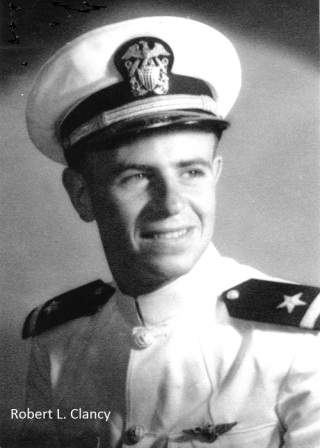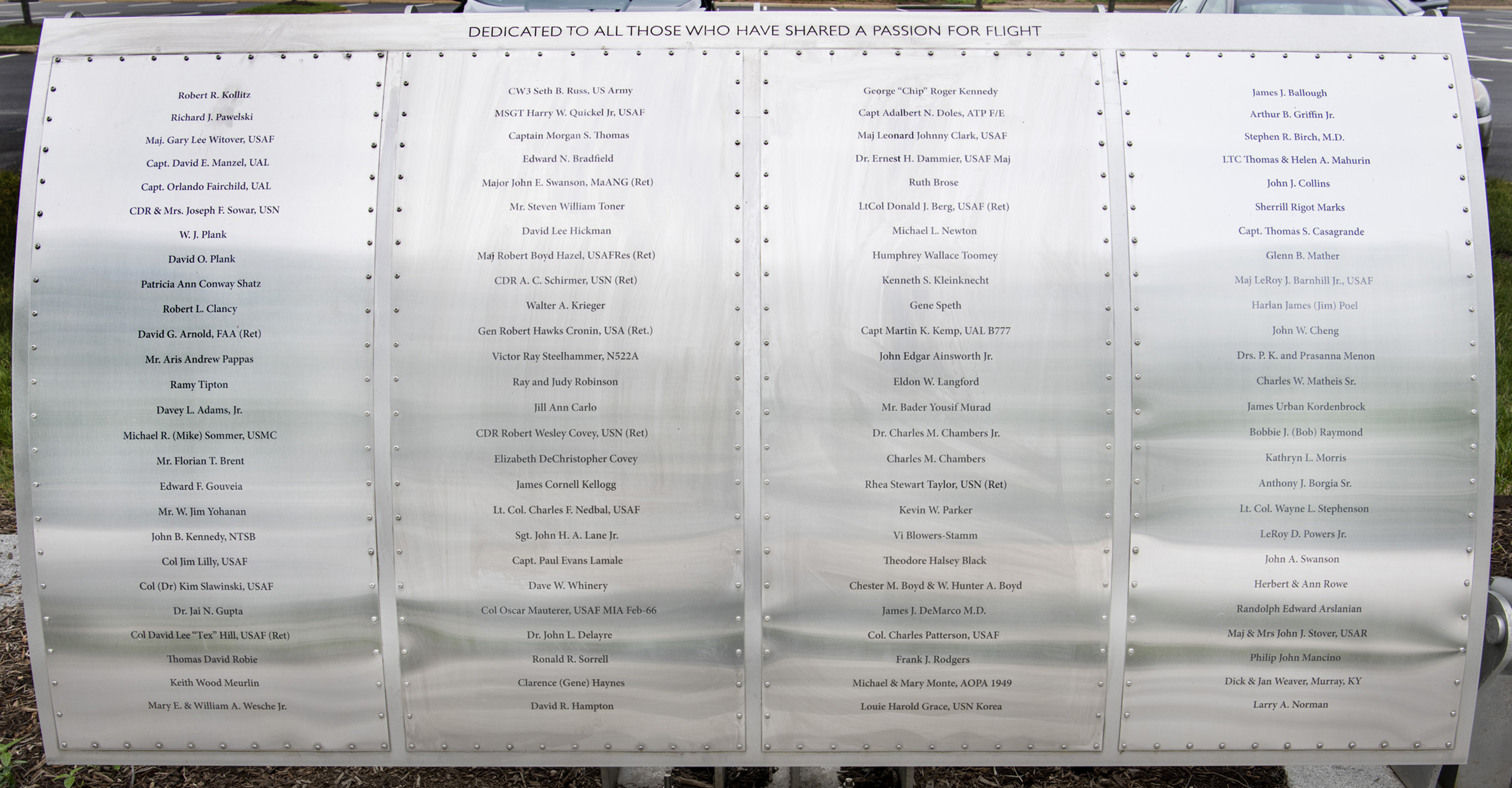
Foil: 38 Panel: 1 Column: 1 Line: 10
Wall of Honor Level:
Air and Space Leader
Honored by:
Mr. John Clancy
In response to the Japanese bombing of the United States fleet in Pearl Harbor, Hawaii on December 7, 1941, Robert Lawrence Clancy of Fresno, California applied to and was accepted by the Naval Aviation Cadet Selection Board in San Francisco for civilian flight training (CPT) in January of 1942.
The CPT was conducted at Bishop California and then at Carson City, Nevada and by August of 1942, with a civilian pilot license in hand, he was sent to St. Mary’s in Moraga, California for military pre-flight training and physical conditioning.
By December of 1942, primary flight training was being completed in Livermore, California and then it was on to Naval Air Station Corpus Christi, Texas for advanced flight training. Upon successfully completing flight training at Corpus Christi, “Clancy”, as he was affectionately known by his squadron mates, was commissioned as a naval officer with the rank of Ensign and received the coveted “wings of gold” in May of 1943.
Flying the SN-J, Clancy was now assigned to NAS Opalaka, Florida for Operational Flight Training, which was completed about August of 1943. It was then on to NAS Glenview, Michigan where arrested carrier landings were practiced again and again aboard the WOLVERINE, a converted ferryboat which had been converted to a flattop for practice purposes. With sufficient carrier” quals” under his belt, it was on to NAS Alameda where Airgroup EIGHTEEN was formed and then on to the auxiliary airfield near Watsonville for more training in the SBD Douglass Dauntless, a divebomber, and practice with fellow pilots who flew the torpedo planes. Training also continued into December of 1943 at NAS Crows Landing, California, in the Curtis Helldiver.
Catching a ride aboard USS YORKTOWN out of Alameda and through the Golden Gate Bridge, Clancy sailed for Hilo, Hawaii in January of 1944. From Hilo, it was on to the Marine Corps Air Station at Kaneohe, Hawaii, where newer, faster and heavier versions of the Helldiver SB2C4 were accepted and flown along with the reliable SBD, Douglass Dauntless. About a dozen additional new SB2C4s were accepted by Bombing Group EIGHTEEN at Ford Island, Oahu and in June of 1944, LTjg Clancy flew aboard the USS INTREPID in the open Pacific about 100 miles off the Hawaiian Island chain.
The buildup of the nation’s defense capability, with much of its fleet lying at the bottom of Pearl Harbor, takes time. To prepare to fight, and to maintain and to sustain fighting forces takes time.
The capital ship of the day, the battleship, was rapidly giving way to the aircraft carrier as the major seagoing combatant. Building and equipping the carriers with weapons platforms (aircraft) which can do the job, that is, put ordinance on target, also takes time.
World War II proved that the U.S. aviators are the best in the world but their training also takes time and considerable hard work. Only the best candidates are selected for training and many of them are unable to complete the rigorous training for a whole variety of reasons.
The soon to be famous USS INTREPID (CV-11) was an Essex class aircraft carrier. She was the third of twenty-four such class of carriers. The INTREPID’s hull was laid down by builder Newport News on 1 December 1941, she was launched 26 April 1943 and was commissioned 16 August 1943, at which time shake down cruises were made to train the ships company in the steaming, navigational and operational aspects of her work. The INTERPID was 820 feet in length, about 35,000 tons of displacement, and carried between 91-100 aircraft. As INTREPID joined the Pacific fleet with other famous ships including New Jersey class battleships (with their 16-inch guns) and the new cruisers and destroyers (all bristling with antiaircraft weapons) large task forces were being formed for battle with the Japanese.
In June of 1944, Bombing Squadron EIGHTEEN, called the “Sunday Punchers”, was attached to the INTREPID and flew aboard. Clancy was bound for full blown battle with the Japanese Imperial Navy, and the carrier air war was in full, raging process.
The American Navy was now ready for a return to the Philippines but began it with a U.S. Navy thrust through the Gilbert, Marshall and Mariana Islands of the Central Pacific. Once captured, these islands would serve as bases for our attack on the Philippines and eventually Japan. At the same time, U.S. Army forces, led by General Douglas MacArthur and protected by naval units, drove the Japanese from New Guinea.
The Battle of the Philippine Sea (19-20 June, 1944) became known as “The Great Marianas Turkey Shoot” and resulted in the splashing down of 373 Japanese planes.
By 12 October 1944, Clancy, with his Bombing Squadron EIGHTEEN flying off the USS INTREPID, was engaged with the enemy on the island of Formosa in the South China Sea. Clancy pressed home a glide-bombing attack in the face of intense antiaircraft fire which damaged his plane and scored a direct hit on a large warehouse. For his courage and outstanding airmanship, Lieutenant (then Lieutenant, Junior Grade) Clancy was awarded the DISTINGUISHED FLYING CROSS.
The four battles of the Philippine Sea which together were called the Battle for Leyte Gulf, took place 23-26 October, 1944. LTjg Clancy was in the thick of it.
By October 24, 1944, LTjg Clancy pressed home a dive-bomb attack and scored a possible direct hit on an enemy battleship, despite intense antiaircraft fire which shot off part of his plane’s controls. For this courageous act, he was awarded the SILVER STAR MEDAL for conspicuous gallantry and intrepidity.
But, the battle continued to rage and in the highest traditions of the United States Naval Services, so did Lieutenant Clancy, who on 26 October, 1944 while piloting his bomber aircraft and braving against intense antiaircraft fire, pressed home and scored a direct hit on an enemy battleship with his full bomb load, “thereby contributing materially to the annihilation of a hostile carrier Task Force.” For his “extraordinary heroism”, Robert Lawrence Clancy, citizen soldier of the United States Naval Reserve was awarded this nation’s second highest medal, the NAVY CROSS.
And again, on 25 November 1944, while participating in a mission against enemy Japanese forces in the Philippine Islands Area, Lieutenant Clancy, daringly attacked and contributed to the complete destruction of three enemy mine layers and one escort vessel. For these meritorious achievements he was awarded the AIR MEDAL, to add to the others.
Wall of Honor profiles are provided by the honoree or the donor who added their name to the Wall of Honor. The Museum cannot validate all facts contained in the profiles.
Foil: 38
All foil images coming soon.View other foils on our Wall of Honor Flickr Gallery
